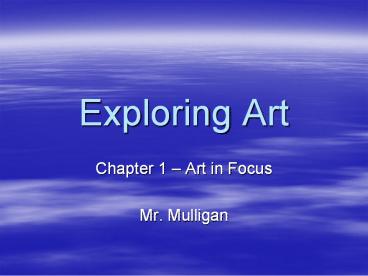Exploring Art PowerPoint PPT Presentation
Title: Exploring Art
1
Exploring Art
- Chapter 1 Art in Focus
- Mr. Mulligan
2
What is Art?
- The arts are a basic form of human communication.
- The visual arts, music, literature, and poetry
may be considered the means by which people, past
and present, express themselves in unique sights
and sounds that capture the interest, imagination
and appreciation of others.
3
Visual Arts
- Scholars have tried to establish the qualities
that identify an object as a work of art.
4
Qualities of a Work of Art
- 1. Art should mirror reality. It must look like
something seen in the real world
5
Qualities of a Work of Art
- 2. Art must be pleasing to the eye, even if it is
not realistic.
6
Qualities of a Work of Art
- 3. Art should express the artists ideas,
beliefs, and feelings so that others can
understand them - Figure 1.5 on page 8 Hugo Robus - Despair
7
Various Forms of art
- Two primary forms art fine arts and applied arts.
- Fine Arts- refers to painting, sculpting, and
architecture, arts which have no practical
function, valued on their visual pleasure they
provide or their success in communicating ideas
or feelings.
8
New Jersey Grounds for Sculpture
Fine Art
Elizabeth Catlett Mother and Child
9
Various Forms of art
- Applied Art the design or decoration of
functional objects to make them pleasing to the
eye. - Made either by hand or machine
- Intended primarily to serve a useful function
- Artisans, designers and craftspeople
10
Applied ArtIkea furniture
11
Why Art is Created
- Aesthetics
- Simply for its visual appeal and the pleasure it
brings - Morals/Ethics
- Depict people and behaviors that reflect morality
- Spirituality
- Enables people to connect with the spiritual
world - History
- Provide valuable information about people, places
and events - Politics
- Used as a tool of persuasion or propaganda
12
Why Artists Create
- Wealth?
- Titian earned huge commissions and lived like a
prince - while Rembrandt ended his last days bankrupt
- Recognition and Glory?
- Not all received fame Judith Leyster
(1609-1660) was completely ignored for
generations - Regardless of the artists culture or
nationality, all artists seem to have one trait
in common They are driven by the impulse to
create.
13
Why should you study art
- You might wonder why you should involve yourself
in the creation of art. - When you create original works of art, you
experience the creative process - Presented with a puzzling visual problem, you
learn how approach the problem and resolve it as
an artist might. - You develop your own capabilities for
self-expression
14
Why should you study art
- 1. Self-Expression
- Assume for a moment that you want to express an
idea or emotion in a work of art. - As you create you look for ways to convey this
idea or feeling to others. - This task involves more than manipulating
material with your hands, it also requires that
you use your mind to draw upon your emotions.
15
Starry Night
Munch
Van Gogh
16
2. Decision Making and Problem Solving
Why should you study art
- What subject should I paint or sculpt?
- Which medium and technique should I use?
- What colors, shapes, lines and textures should I
emphasize? - How can I arrange these elements effectively?
- How will I recognize that the work is finished
and the creative process has ended?
17
Why should you study art
3. Real-World Connections
- Clarify the problems
- Identify Possible Solutions
- Test each possible solution
- Select the solution that seems most appropriate
- Apply the Solution
- Determine whether the solution resolves the
problem
18
Art Media
- Materials used by artist to create artworks
- Can include pencils, charcoal, paint, clay,
stone, and metal
19
Art Processes
- The action involved in making the art
- Can include drawing, painting, printmaking
modeling, weaving digitizing, and casting
20
Aesthetics
- Branch of Philosophy
- Dealing with the nature of art, beauty, and taste
21
Art Criticism
- The criteria, or standards of judgment you will
need when making decisions about art. - The four steps of art criticism are
- 1. Description
- 2. Analysis
- 3. Interpretation
- 4. Judgment
22
- 2-dimensional Art Flat art without physical
depth - 3-dimensional Art Art viewed from all sides
23
The Creative Formula
- Spark (inspiration) start with a problem to be
solved brainstorm observe become aware of
relationships. - Planning (calculation) decision-making phase.
Selection of materials. Refine visual elements
gather visual references. - Communication (execution) create the project.
Maintain craftsmanship, and integrity

